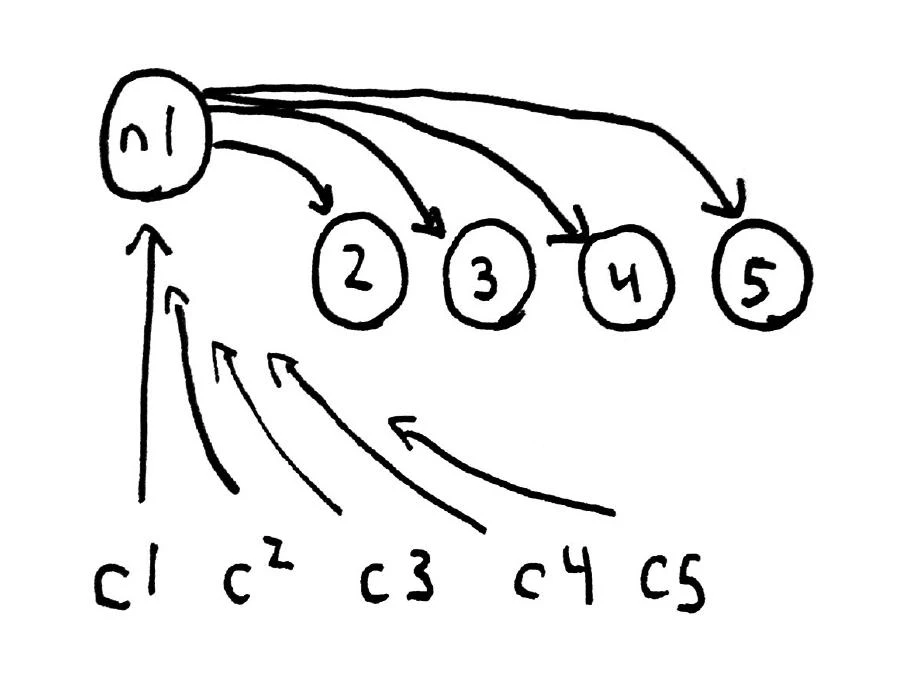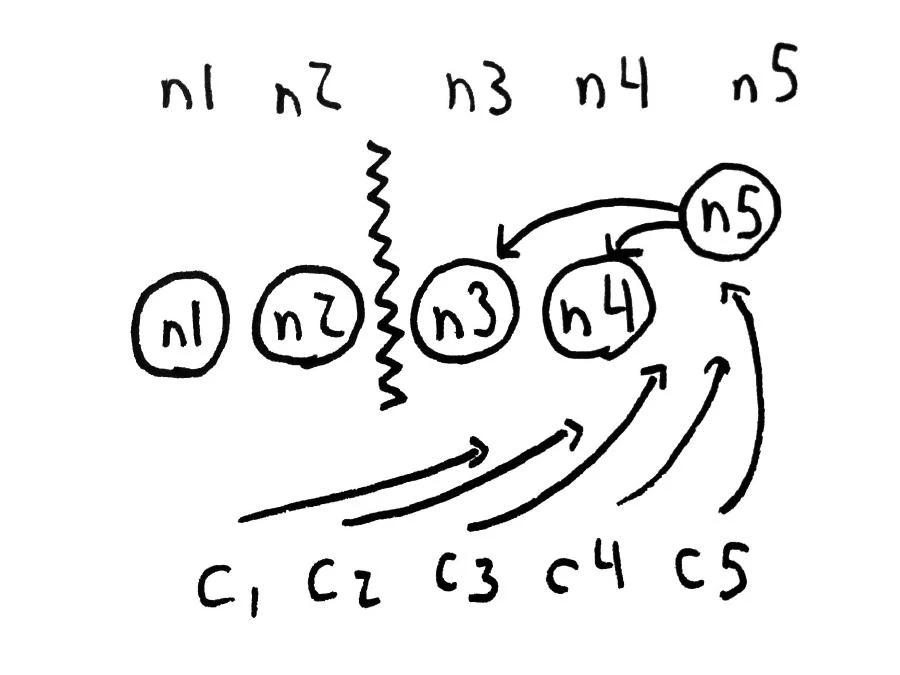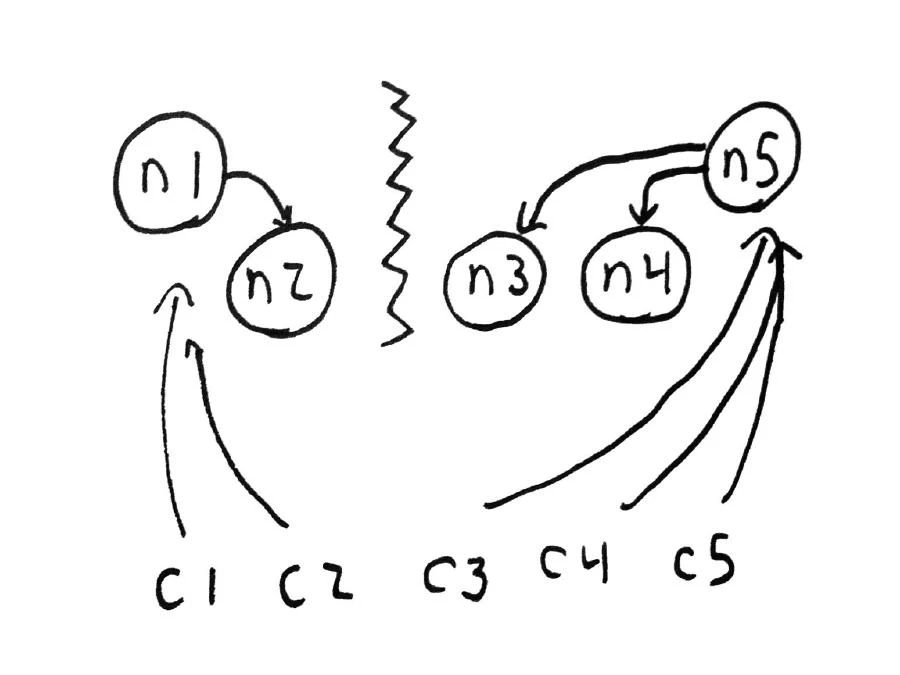Previously on Jepsen, we explored two-phase commit in Postgres. In this post, we demonstrate Redis losing 56% of writes during a partition.
Redis is a fantastic data structure server, typically deployed as a shared heap. It provides fast access to strings, lists, sets, maps, and other structures with a simple text protocol. Since it runs on a single server, and that server is single-threaded, it offers linearizable consistency by default: all operations happen in a single, well-defined order. There’s also support for basic transactions, which are atomic and isolated from one another.
Because of this easy-to-understand consistency model, many users treat Redis as a message queue, lock service, session store, or even their primary database. Redis running on a single server is a CP system, so it is consistent for these purposes.
What about high availability?

Redis offers asynchronous primary->secondary replication. A single server is chosen as the primary, which can accept writes. It relays its state changes to secondary servers, which follow along. Asynchronous means that you don’t have to wait for a write to be replicated before the primary returns a response to the client. Writes will eventually arrive on the secondaries, if we wait long enough. In our application, all 5 clients will read from the primary on n1, and n2–n5 will be secondaries.
This is still a CP system, so long as we never read from the secondaries. If you do read from the secondaries, it’s possible to read stale data. That’s just fine for something like a cache! However, if you read data from a secondary, then write it to the primary, you could inadvertently destroy writes which completed but weren’t yet replicated to the secondaries.
What happens if the primary fails? We need to promote one of the secondary servers to a new primary. One option is to use Heartbeat or a STONITH system which keeps a link open between two servers, but if the network partitions we don’t have any way to tell whether the other side is alive or not. If we don’t promote the primary, there could be no active servers. If we do promote the primary, there could be two active servers. We need more nodes.
If one connected component of the network contains a majority (more than N/2) of nodes, we call it a quorum. We’re guaranteed that at most one quorum exists at any point in time–so if a majority of nodes can see each other, they know that they’re the only component in that state. That group of nodes (also termed a “component”) has the authority to promote a new primary.
Redis has a system called Sentinel, which, when configured correctly, will try to establish a quorum between Sentinel nodes, agree on which Redis servers are alive, and promote any which appear to have failed. If we colocate the Sentinel nodes with the Redis nodes, this should allow us to promote a new primary in the majority component (should one exist).


What are the consistency and availability properties of Sentinel? Antirez, the author of Redis, says:
Redis Cluster for instance is a system biased towards consistency rather than availability. Redis Sentinel itself is an HA solution with the dogma of consistency and master slave setups."
So we expect this system to be CP. Nodes in the minority component will become unavailable during the partition, and the majority component will elect a new primary. The Sentinels will then order clients to abandon the old primary and reconnect to the new one.

Before we begin, it’s important to recognize that Redis does not guarantee durability. Since writes to disk and replication to secondaries are asynchronous, we can lose up to N seconds of the most recent writes. We should not, however, see gaps in the write log. If write n is present, so are writes 0, 1, … n-2, n-1.
Partitioning the cluster
Here’s a simple application which writes a list of numbers to a Redis set. At this time Carmine, the Clojure Redis client, doesn’t yet support failover using Sentinel. I’ve implemented a stricter version of the Sentinel client algorithm here: asking the server for a new primary before every write. Sentinel actually states that clients should only select new primaries when their connection is closed, which leaves a wider window for clients to disagree about which primary to use–leading to the possibility of more conflicting writes.
Let’s give it a shot. First, set up Redis:
salticid redis.setup
Then, in two terminals, start up Redis and Redis Sentinel:
salticid redis.start
salticid redis.sentinel
You should see messages go by as the sentinels discover one another and ensure all the nodes are properly configured. You can check the replication status with salticid redis.replication. salticid redis.stop will shut down the Redis servers and sentinels alike.
Now let’s run our application with lein run redis, then partition nodes n1 and n2 away from n3, n4, and n5 by running salticid jepsen.partition.
376 :ok
378 :ok
382 :ok
384 :ok
380 :ok
381 :ok
383 :ok
389 :ok
385 :ok
The first thing you’ll notice is that even though n1 can’t possibly be replicating its writes to n3, n4, and n5, writes against it are still completing successfully. N1 still thinks it’s the primary, and since replication is asynchronous, it’s acknowledging writes before they’re sent to others in the cluster. The sentinels notice the failure, and n3, n4, and n5’s sentinels promote a new primary:
19 May 00:37:36.314 # +sdown master mymaster 10.10.3.242 6379
19 May 00:37:36.616 # +sdown slave 10.10.3.52:6379 10.10.3.52 6379 @ mymaster 10.10.3.242 6379
19 May 00:37:36.816 # +sdown sentinel 10.10.3.52:26379 10.10.3.52 26379 @ mymaster 10.10.3.242 6379
19 May 00:37:36.816 # +sdown sentinel 10.10.3.242:26379 10.10.3.242 26379 @ mymaster 10.10.3.242 6379
19 May 00:37:37.521 # +odown master mymaster 10.10.3.242 6379 #quorum 3/3
19 May 00:37:48.041 # +failover-detected master mymaster 10.10.3.242 6379
19 May 00:37:48.142 * +slave-reconf-inprog slave 10.10.3.101:6379 10.10.3.101 6379 @ mymaster 10.10.3.242 6379
19 May 00:37:48.143 * +slave-reconf-inprog slave 10.10.3.95:6379 10.10.3.95 6379 @ mymaster 10.10.3.242 6379
19 May 00:37:49.145 * +slave-reconf-done slave 10.10.3.101:6379 10.10.3.101 6379 @ mymaster 10.10.3.242 6379
19 May 00:37:49.145 * +slave-reconf-done slave 10.10.3.95:6379 10.10.3.95 6379 @ mymaster 10.10.3.242 6379
19 May 00:37:49.243 # +failover-end master mymaster 10.10.3.242 6379
Now n5 is a new primary–but n1 is still a primary too! Run salticid redis.replication to see the replication status of all nodes. We have two primary nodes, one in each component of the system. During this time both primaries are accepting writes independently. This is a classic split-brain scenario–and it violates the C in CP. Writes (and reads) in this state are not linearizable, because clients will see different results based on which node they’re talking to.


Healing the partition
What happens when the network comes back online? salticid jepsen.heal repairs the partition, and the Sentinel nodes will discover each other again.
Redis Sentinel used to leave both primaries running indefinitely, which meant that any scenario like a partition or crash leading to failover would result in permanent split-brain. That’s fixed in version 2.6.13, which came out last week. Now, Sentinel demotes the old primary on n1 when it comes back into contact with the majority component. The client sees:
1687 :ok
1686 READONLY You can't write against a read only slave.
1690 READONLY You can't write against a read only slave.
1693 :ok
… since n1 stepped down just after a Sentinel told us it was a primary. Clients are a part of the distributed system too. If a system’s correctness depends on clients choosing specific nodes at specific times, the clients are now engaged in a distributed consensus problem–not to mention a clock synchronization problem. This is damn hard to do correctly.
Results
1991 :ok
1995 :ok
1996 :ok
Hit enter when ready to collect results.
Writes completed in 42.002 seconds
2000 total
1998 acknowledged
872 survivors
1126 acknowledged writes lost! (╯°□°)╯︵ ┻━┻
50 51 52 53 54 55 ... 1671 1675 1676 1680 1681 1685
0.999 ack rate
0.5635636 loss rate
0.0 unacknowledged but successful rate
Out of 2000 writes, Redis claimed that 1998 of them completed successfully. However, only 872 of those integers were present in the final set. Redis threw away 56% of the writes it told us succeeded.

There are two problems at work here. First, notice that all the clients lost writes at the beginning of the partition: (50, 51, 52, 53, …). That’s because they were all writing to n1 when the network dropped–and since n1 was demoted later, any writes made during that window were destroyed.
The second problem was caused by split-brain: both n1 and n5 were primaries up until the partition healed. Depending on which node they were talking to, some clients might have their writes survive, and others have their writes lost. The last few numbers in the set, mod 5, are all 0 and 1: the clients which kept using n1 as a primary, in the minority partition.
Note that both of these failure modes violate the durability guarantees we claimed earlier for Redis, because there are gaps in the write log.
Redis strategies
So you’re running a distributed Redis install, and have realized that the design of Redis Sentinel (or, for that matter, any other failover system on top of an asynchronously replicated primary-secondary design) means you can lose a lot of data when a partition occurs. What can you do?
From an operations perspective, I recommend you try to understand the Sentinel consensus algorithm. I don’t, and I’ve read it a dozen times.
I tried to write a formal verification of the algorithm in TLA+, and failed. There are dozens of interacting rules which can lead to phenomenally complex edge cases. The whole thing relies on clocks–and a special mode, TILT, which tries to detect sudden clock skew. You can specify a quorum which is smaller than the number of sentinels, allowing multiple quorums to operate simultaneously. Since the system auto-discovers peers, you’ve got to make sure nobody lets a new sentinel talk to your cluster, or you might find yourself with a quorum smaller than N/2. Client, sentinel, and Redis server topologies are all different things, which (I think) means…
- Sentinels could promote a node no clients can see
- Sentinels could demote the only node clients can actually reach
- Sentinels could assume a totally connected group of servers is unavailable
- Sentinels could promote an isolated node in a minority component, then destroy data on the majority by demoting their primary later
I (tentatively) recommend running exactly one sentinel on each server node, to force server and sentinel network topologies to align. Unless the partition doesn’t happen in the network, but somewhere upwards of layer 3. Let’s not talk about that possibility.
As an application developer working with Redis, one option is simply to estimate and accept your data loss. Not all applications have to be consistent. Microsoft estimates their WAN links have about 99.5% availability, and their datacenter networks are about 10x more reliable, going down for about 4 hours per year. Not all network failures result in this kind of partition. If you’re running good network hardware in redundant configurations in real datacenters (e.g. not EC2), you cut your probability of partition down pretty far. Plenty of important applications can tolerate data loss for a few hours a year.
If you can’t tolerate data loss, Redis Sentinel (and by extension Redis Cluster) is not safe for use as:
- A lock service
- A queue
- A database
If you use Redis as a lock service, this type of partition means you can take out the same lock twice–or up to N times for N nodes! Or maybe multiple times concurrently, against the same node, if you want to get weird about it. Write loss means locks can be resurrected from the dead, or vanish even when supposedly held. Bottom line: distributed lock services must be CP. Use a CP consensus system, like Zookeeper.
If you use Redis as a queue, it can drop enqueued items. However, it can also re-enqueue items which were removed. An item might be delivered zero, one, two, or more times. Most distributed queue services can provide reliable at-most-once or at-least-once delivery. CP queue systems can provide reliable exactly-once delivery with higher latency costs. Use them if message delivery is important.
If you use Redis as a database, be prepared for clients to disagree about the state of the system. Batch operations will still be atomic (I think), but you’ll have no inter-write linearizability, which almost all applications implicitly rely on. If you successfully write A, then B, you expect that any client which can see B can also see A. This is not the case. Be prepared for massive write loss during a partition, depending on client, server, and sentinel topology.
Because Redis does not have a consensus protocol for writes, it can’t be CP. Because it relies on quorums to promote secondaries, it can’t be AP. What it can be is fast, and that’s an excellent property for a weakly consistent best-effort service, like a cache. Redis Sentinel can do a great job of keeping your caches warm even in the face of network and node failure, and helping clients to gradually discover the correct nodes to interact with. Use Redis Sentinel for caching, sampling, statistics, and messaging where getting the wrong answer doesn’t hurt much. Occasional windows of 50% write loss may be just fine for your user feeds, hit counters, or upvotes.
In the next post, we’ll learn about a database with a related replication architecture: MongoDB.
Kyle, thanks for your incredible serie of blog posts!
My reply about Redis Sentinel is here -> http://antirez.com/news/55